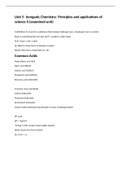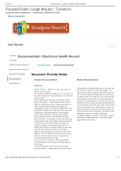Lecture notes
Unit 5 chemistry revision booklet- covers ALL chemistry unit 5!
- Institution
- PEARSON (PEARSON)
This document is a revision booklet for btec applied science level 3 unit 5 principles and applications of science II chemistry section. I received 35/40 on my chemistry mock exam using this revision booklet. This is a booklet i have put together myself which covers the chemistry section of the uni...
[Show more]




